

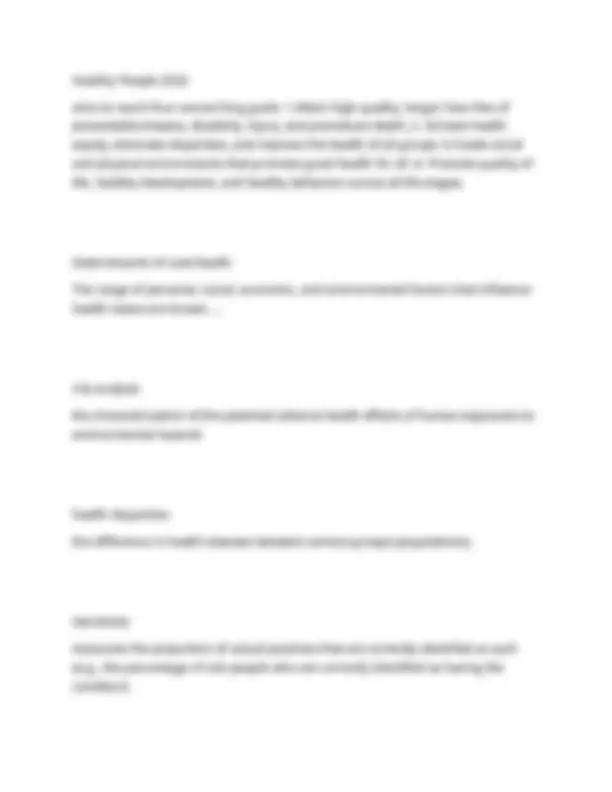
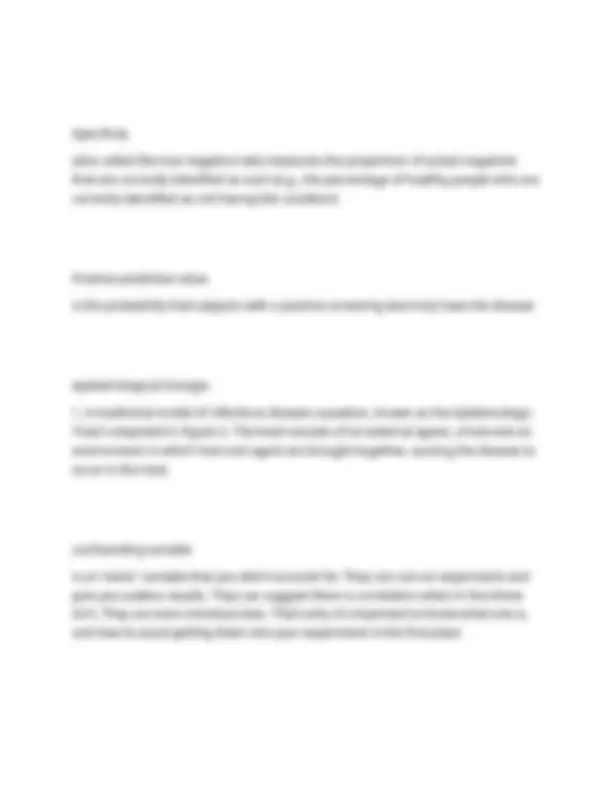
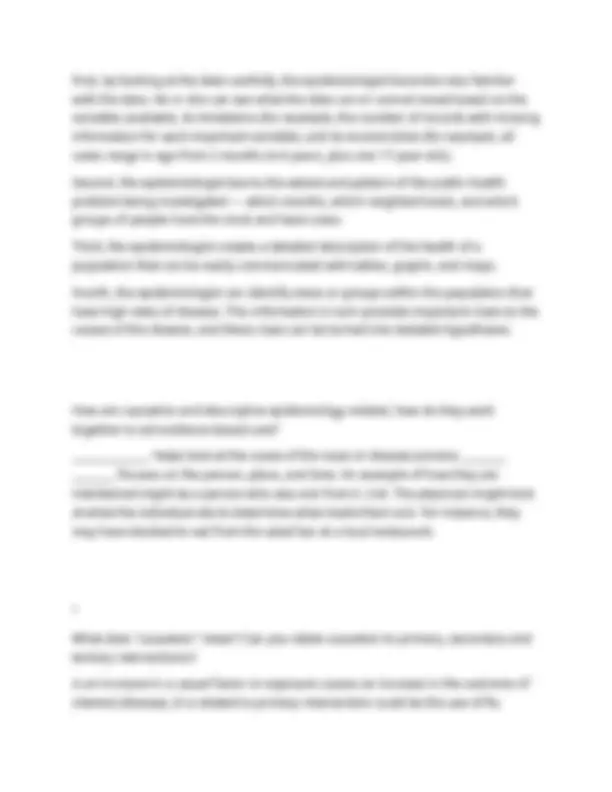
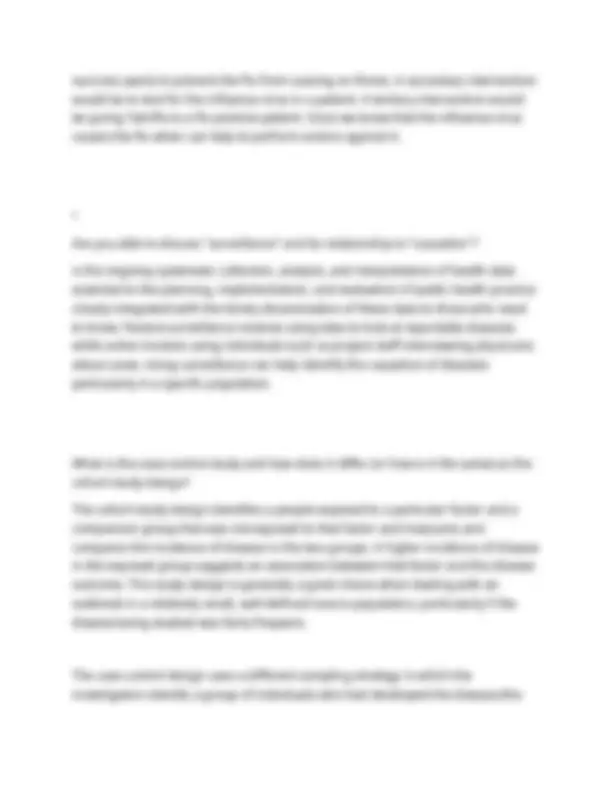
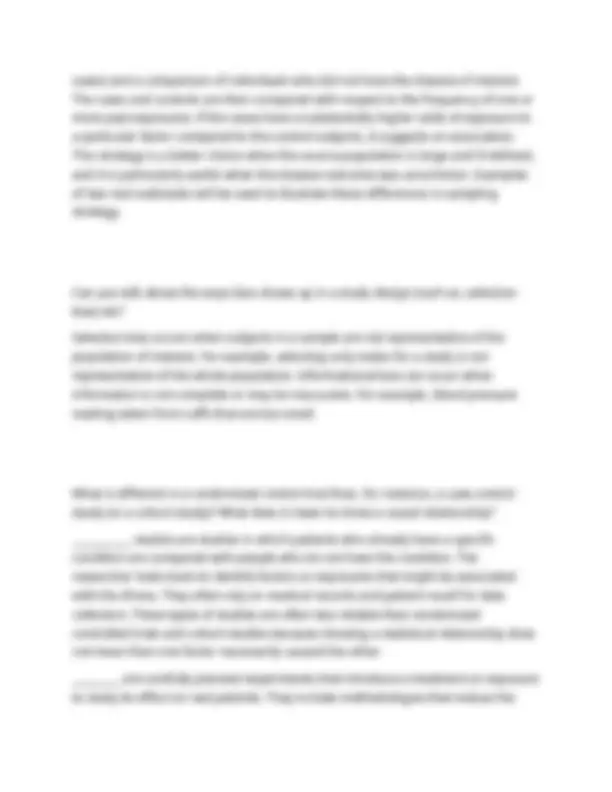
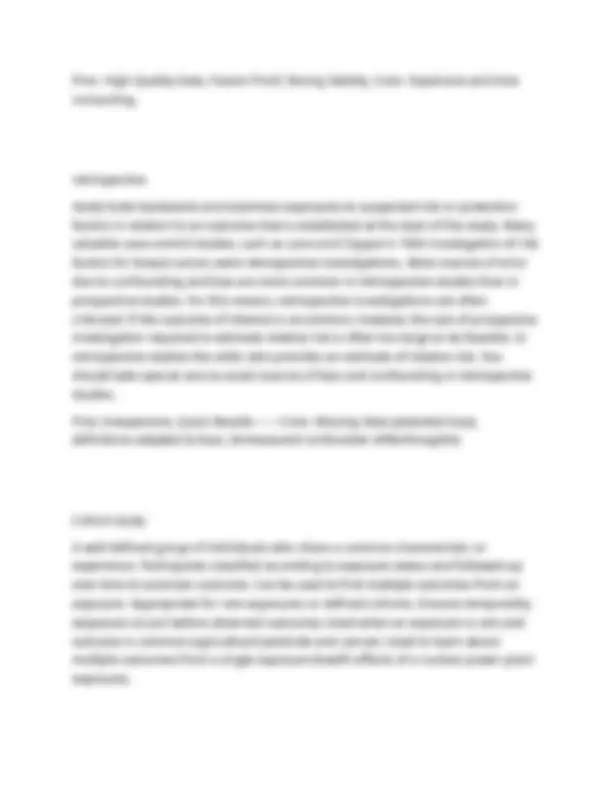
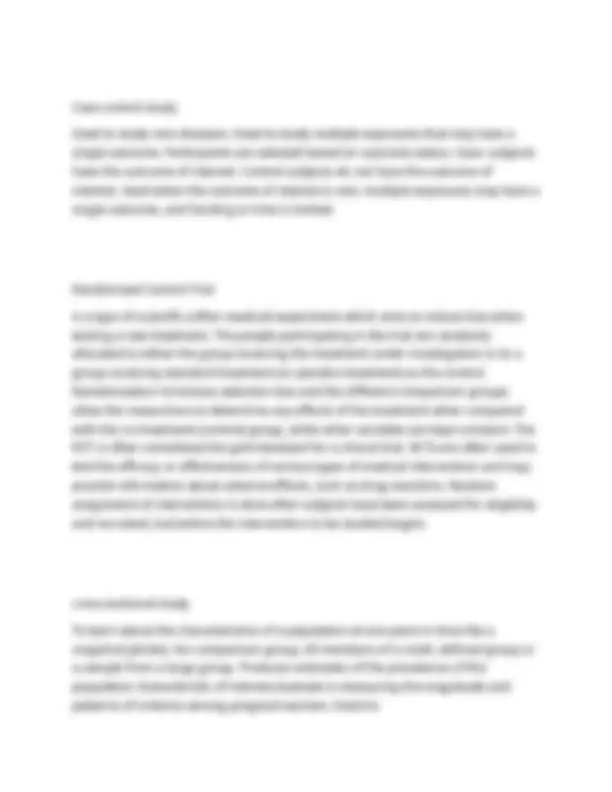
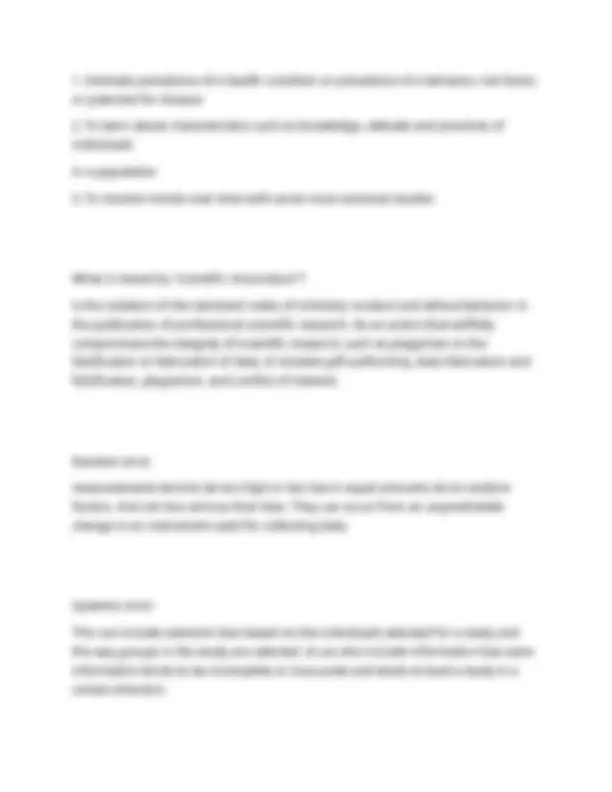
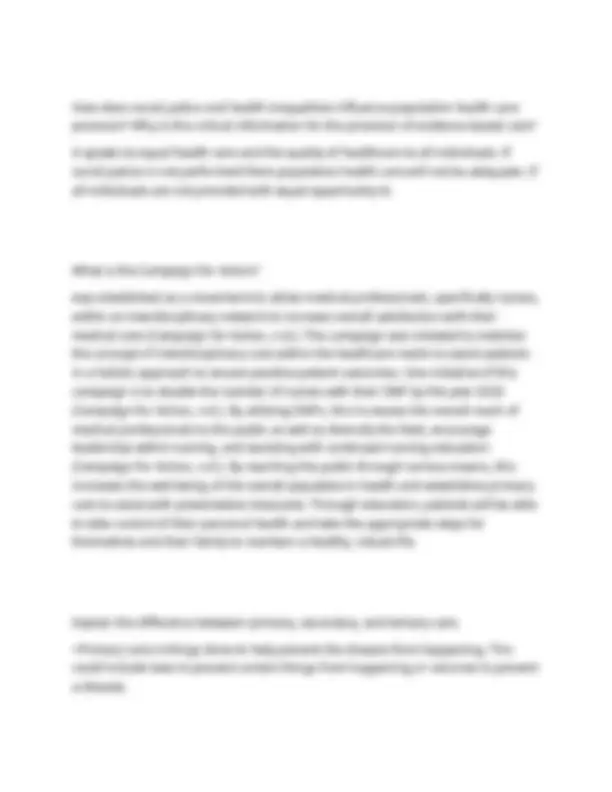
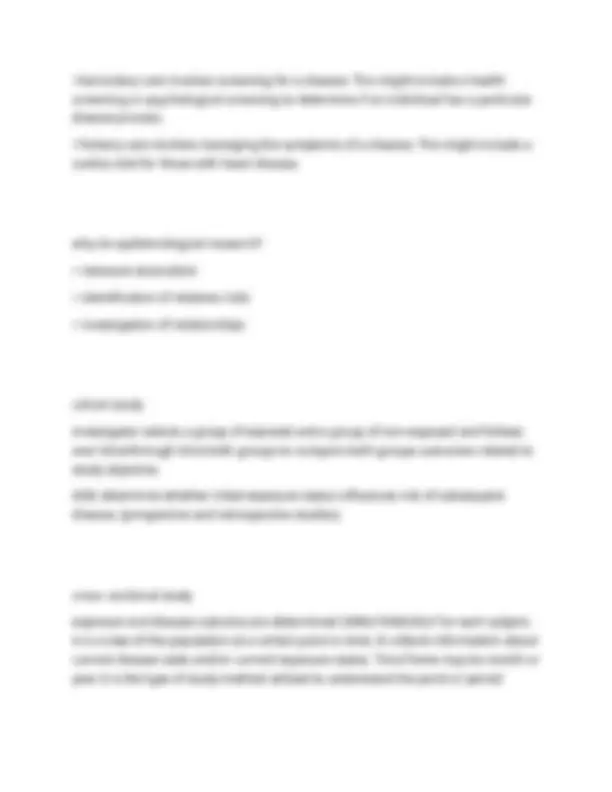





Study with the several resources on Docsity

Earn points by helping other students or get them with a premium plan


Prepare for your exams
Study with the several resources on Docsity

Earn points to download
Earn points by helping other students or get them with a premium plan
Community
Ask the community for help and clear up your study doubts
Discover the best universities in your country according to Docsity users
Free resources
Download our free guides on studying techniques, anxiety management strategies, and thesis advice from Docsity tutors
NR503 MIDTERM EXAM ALL CORRECT AND GRADED A+
Typology: Exams
1 / 22

This page cannot be seen from the preview
Don't miss anything!















Epidemiology is the science of public health Population Health focuses on risk, data, demographics, and outcomes. Outcomes is the end result that follows an intervention aggregate is a defined population. community is composed of multiple aggregates
data is complied information Prevalence measures the existence of a disease. Measures the number of all cases of a disease or attribute in a population at a given time Incidence measures the appearance of a disease. Measures the occurrence of new events in a population over a period of time. surveillance is the collection, analysis, and dissemination of data. high-risk is an increased chance of poor health outcome. Morbidity is the presence of illness in a population
Healthy People 2020 aims to reach four overarching goals: 1.Attain high-quality, longer lives free of preventable disease, disability, injury, and premature death, 2. Achieve health equity, eliminate disparities, and improve the health of all groups 3.Create social and physical environments that promote good health for all. 4. Promote quality of life, healthy development, and healthy behaviors across all life stages. Determinants of care/health The range of personal, social, economic, and environmental factors that influence health status are known ... risk analysis the characterization of the potential adverse health effects of human exposures to environmental hazards health disparities the difference in health statuses between various groups (populations). Sensitivity measures the proportion of actual positives that are correctly identified as such (e.g., the percentage of sick people who are correctly identified as having the condition)
Specificity (also called the true negative rate) measures the proportion of actual negatives that are correctly identified as such (e.g., the percentage of healthy people who are correctly identified as not having the condition) Positive predictive value is the probability that subjects with a positive screening test truly have the disease epidemiological triangle
Study:Examine the results. Did you achieve your goals? Act: Use your results to make a decision, incorporate changes into your workflow, and establish future quality improvement plans Is screening a tertiary intervention? If yes, why, if not, what is it? No, it is secondary. How does a provider determine the usefulness, appropriateness, of a screening test? Where would and NP look to find a screening test? What determines if a screening test should be used? Determining whether a screening test is appropriate requires the APRN to address several aspects of the disease of interest. The target population needs to be identifiable. There should be enough people to make the study cost effective. The preclinical period should be proficient to allow treatment before symptoms appear so that early diagnosis and treatment make a difference in terms of outcomes. The NP could look at the U.S. Preventative Services Task Force, Agency for Healthcare Research and Quality, and SAMHSA-HRSA to find a screening test. Sensitivity and specificity measure the validity of a test. Sensitivity is the number identified/ the number affected. Specificity is the number identified in the screening of not having the disease/ the actual number who do not have the disease. Can you explain what "descriptive epidemiology" means? What is the purpose? How is it used? It covers time place and person.
First, by looking at the data carefully, the epidemiologist becomes very familiar with the data. He or she can see what the data can or cannot reveal based on the variables available, its limitations (for example, the number of records with missing information for each important variable), and its eccentricities (for example, all cases range in age from 2 months to 6 years, plus one 17-year-old.). Second, the epidemiologist learns the extent and pattern of the public health problem being investigated — which months, which neighborhoods, and which groups of people have the most and least cases. Third, the epidemiologist creates a detailed description of the health of a population that can be easily communicated with tables, graphs, and maps. Fourth, the epidemiologist can identify areas or groups within the population that have high rates of disease. This information in turn provides important clues to the causes of the disease, and these clues can be turned into testable hypotheses. How are causation and descriptive epidemiology related, how do they work together to aid evidence-based care? ______________- helps look at the cause of the issue or disease process. ________ ________ focuses on the person, place, and time. An example of how they are intertwined might be a person who was sick from E. Coli. The physician might look at what the individual ate to determine what made them sick. For instance, they may have decided to eat from the salad bar at a local restaurant. ° What does "causation" mean? Can you relate causation to primary, secondary and tertiary interventions? is an increase in a casual factor or exposure causes an increase in the outcome of interest (disease). It is related to primary intervention could be the use of flu
cases) and a comparison of individuals who did not have the disease of interest. The cases and controls are then compared with respect to the frequency of one or more past exposures. If the cases have a substantially higher odds of exposure to a particular factor compared to the control subjects, it suggests an association. This strategy is a better choice when the source population is large and ill-defined, and it is particularly useful when the disease outcome was uncommon. Examples of two real outbreaks will be used to illustrate these differences in sampling strategy. Can you talk about the ways bias shows up in a study design (such as, selection bias) etc? Selection bias occurs when subjects in a sample are not representative of the population of interest. For example, selecting only males for a study is not representative of the whole population. Informational bias can occur when information is not complete or may be inaccurate. For example, blood pressure reading taken from cuffs that are too small. What is different in a randomized control trial than, for instance, a case-control study (or a cohort study)? What does it mean to show a causal relationship? ___________ studies are studies in which patients who already have a specific condition are compared with people who do not have the condition. The researcher looks back to identify factors or exposures that might be associated with the illness. They often rely on medical records and patient recall for data collection. These types of studies are often less reliable than randomized controlled trials and cohort studies because showing a statistical relationship does not mean than one factor necessarily caused the other. _________ are carefully planned experiments that introduce a treatment or exposure to study its effect on real patients. They include methodologies that reduce the
potential for bias (randomization and blinding) and that allow for comparison between intervention groups and control (no intervention) groups. A randomized controlled trial is a planned experiment and can provide sound evidence of cause and effect. A cause relationship means that a cause is linked to the effect. Such as smoking causes increased blood pressure and the effects of increased blood pressure is heart disease. What is each type of study used for, its purpose, and its outcomes? How are the outcomes different in each study design? Measured? Case control studies are studies in which patients who already have a specific condition are compared with people who do not have the condition. The researcher looks back to identify factors or exposures that might be associated with the illness. They often rely on medical records and patient recall for data collection. These types of studies are often less reliable than randomized controlled trials and cohort studies because showing a statistical relationship does not mean than one factor necessarily caused the other. Cohort studies identify a group of patients who are already taking a particular treatment or have an exposure, follow them forward over time, and then compare their outcomes with a similar group that has not been affected by the treatment or exposure being studied. Cohort studies are observational and not as reliable as randomized controlled studies, since the two groups may differ in ways other than in the variable under study. Randomized controlled clinical trials are carefully planned experiments that introduce a treatment or exposure to study its effect on real patients. They include methodologies that reduce the potential for bias (randomization and blinding) and that allow for comparison between intervention groups and control (no
Pros- High Quality Data, Future Proof, Strong Validity, Cons- Expensive and time consuming. retrospective study looks backwards and examines exposures to suspected risk or protection factors in relation to an outcome that is established at the start of the study. Many valuable case-control studies, such as Lane and Claypon's 1926 investigation of risk factors for breast cancer, were retrospective investigations. Most sources of error due to confounding and bias are more common in retrospective studies than in prospective studies. For this reason, retrospective investigations are often criticized. If the outcome of interest is uncommon, however, the size of prospective investigation required to estimate relative risk is often too large to be feasible. In retrospective studies the odds ratio provides an estimate of relative risk. You should take special care to avoid sources of bias and confounding in retrospective studies. Pros: Inexpensive, Quick Results-------Cons- Missing Data (potential bias), definitions adapted to bias, Unmeasured confounder (Afterthoughts) Cohort study A well-defined group of individuals who share a common characteristic or experience. Participants classified according to exposure status and followed-up over time to ascertain outcome. Can be used to find multiple outcomes from an exposure. Appropriate for rare exposures or defined cohorts. Ensures temporality (exposure occurs before observed outcome). Used when an exposure is rare and outcome is common (agricultural pesticide and cancer). Used to learn about multiple outcomes from a single exposure (health effects of a nuclear power plant exposure).
Case-control study Used to study rare diseases. Used to study multiple exposures that may have a single outcome. Participants are selected based on outcome status. Case- subjects have the outcome of interest. Control-subjects do not have the outcome of interest. Used when the outcome of interest is rare, multiple exposures may have a single outcome, and funding or time is limited. Randomized Control Trial is a type of scientific (often medical) experiment which aims to reduce bias when testing a new treatment. The people participating in the trial are randomly allocated to either the group receiving the treatment under investigation or to a group receiving standard treatment (or placebo treatment) as the control. Randomization minimizes selection bias and the different comparison groups allow the researchers to determine any effects of the treatment when compared with the no treatment (control) group, while other variables are kept constant. The RCT is often considered the gold standard for a clinical trial. RCTs are often used to test the efficacy or effectiveness of various types of medical intervention and may provide information about adverse effects, such as drug reactions. Random assignment of intervention is done after subjects have been assessed for eligibility and recruited, but before the intervention to be studied begins cross-sectional study To learn about the characteristics of a population at one point in time like a snapshot (photo). No comparison group. All members of a small, defined group or a sample from a large group. Produces estimates of the prevalence of the population characteristic of interest.Example is measuring the magnitude and patterns of violence among pregnant women. Used to:
Confounding error occurs when it appears that a true association exists between and exposure and outcome, but in reality , this association is confounded by another variable or exposure. What is the highest level of data findings? How is evidence appraised? Level I- Evidence from a systematic review or meta-analysis of all relevant RCTs (randomized controlled trial) or evidence-based clinical practice guidelines based on systematic reviews of RCTs or three or more RCTs of good quality that have similar results. Levels of evidence (sometimes called hierarchy of evidence) are assigned to studies based on the methodological quality of their design, validity, and applicability to patient care. What factors determine quality of care? Effectiveness, patient safety, timeliness, and patient centeredness. How is a websites credibility determined? The medical library association, the Health on the Net Foundation, and the US National Library of Medicine provide guidelines for evaluation online information. Who runs the site? Why have they created the site?
Who is sponsoring the site? Does the information favor the sponsor? Where did the information come from? Is the information sponsored by experts? Is it up to date? What is the privacy policy? What are key indicators when assessing a model of care? Pain Management Consistency of communication Staff Mix Client satisfaction Prevention of Tobacco Use Cardiovascular disease Prevention Caregiver Activity Identification of Primary Caregiver Activities of Daily Living Independent Activities of Daily Living Psychosocial interaction How would you explain the Triple Aim Initiative (model) to a colleague? for Populations seeks to reduce the cost per capita of care, improve the health of population, and enhance patient experience and outcomes
Secondary care involves screening for a disease. This might include a health screening or psychological screening to determine if an individual has a particular disease process. Tertiary care involves managing the symptoms of a disease. This might include a cardiac diet for those with heart disease. why do epidemiological research? measure association identification of relatives risks investigation of relationships cohort study investigator selects a group of exposed and a group of non-exposed and follows over time/through time both groups to compare both groups outcomes related to study objective. AIM; determine whether initial exposure status influences risk of subsequent disease. (prospective and retrospective studies). cross- sectional study exposure and disease outcome are determined SIMULTANEOSLY for each subject. it is a view of the population at a certain point in time. It collects information about current disease state and/or current exposure status. Time frame may be month or year. it is the type of study method utilized to understand the point or period
prevalence rates of a disease. relatively inexpensive and can be conducted within a short time frame. Case-control study investigates relationship between potential risk factors and disease. examines the possible relationship of an exposure to getting a certain disease: a group of individuals with the disease (cases) are compared to a group of people without the disease (controls). This study examines relationships between potential risks factors where disease X (cases) with a sample without disease (X) controls are compared with respect to their exposure to risk factors. example: relationship of smoking to development of coronary heart disease.